Boat Review – by Pat Carson


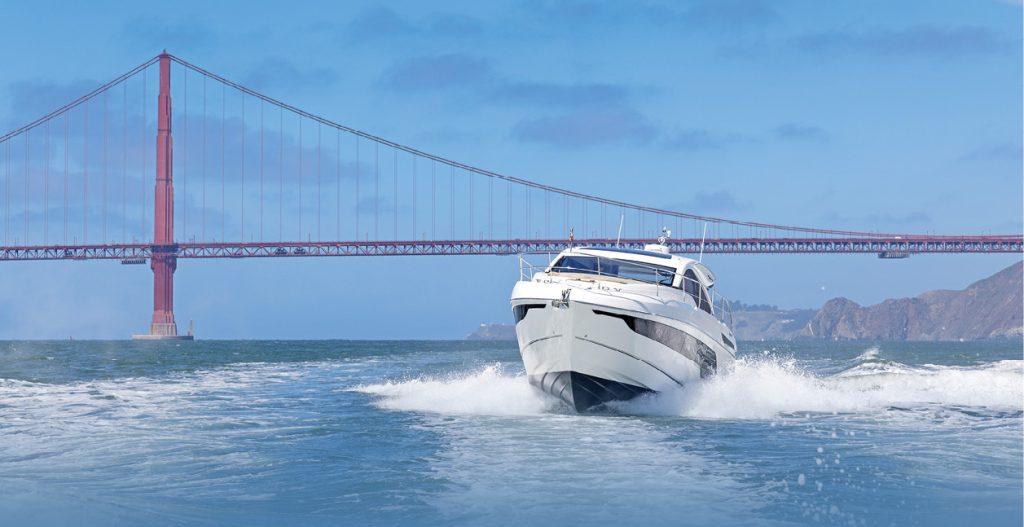
Fairline Targa 45 GT
When the new Fairline Yachts dealer in San Francisco and the wider California region, MRN Yacht Sales, asked if I could move a new and fully commissioned Targa 45 GT demo boat that is currently berthed at Lake Union in Seattle, Washington and needed to be relocated to the San Francisco Bay Area for her new owner, the answer is an immediate yes. Let’s see what the weather looks like. Not only will I be relocating the vessel, but I will have several long days to experience the yacht’s capabilities for a future boat review. If you want to skip my review and just get to the bottom line, I can summarize my review of the Targa 45 GT in three words – I want one!

We landed in Seattle on the early morning flight and arrived at the Lake Union docks before they opened at 0730 and then found our way to the Targa to get started preparing for the long coastal voyage. She was located at the service dock of the Seattle Fairline dealer. They had just completed a full service on the Volvo IPS propulsion system and had her ready to go. Our beautiful Targa was secured starboard side to the dock and when you board you find a somewhat narrow hydraulically operated swim platform. The tradeoff is that Fairline put a swim step deep enough to accommodate a tender, it would now be a 50-foot boat. Instead, the naval architects designed a clever tender garage that is designed for the 485-pound Williams 280 mini jet RIB to be safely tucked away, out of the weather, but easily accessible at the touch of a button when you want it. The garage design is such that the tender sits partially over and between the main engines, thus keeping the weight distribution much more ideally than sticking a 500-pound tender at the very back of the boat. If you do not have or want a tender, just like your home, the garage can store everything else you may need. Access to the engine room is accomplished by lifting the floor of the garage – yes, at the touch of a button. The tender is launched and recovered into the garage with an electric winch that operates at the touch of a button.

Access to the other end of the boat is up two steps on either side of the cockpit and an easy shuffle down the side decks that are wide and easy to navigate to the bow where we find a large sun pad and the ground tackle for the windlass concealed under a locking hatch. Under the hatch it appears as though we have 200 feet of all chain rode feeding through a chain stopper to a recessed anchor roller and then shackled to a highly polished Delta anchor. The Lewmar windlass does all the hard work and is controlled by the touch of a button on the handheld plug-in remote.
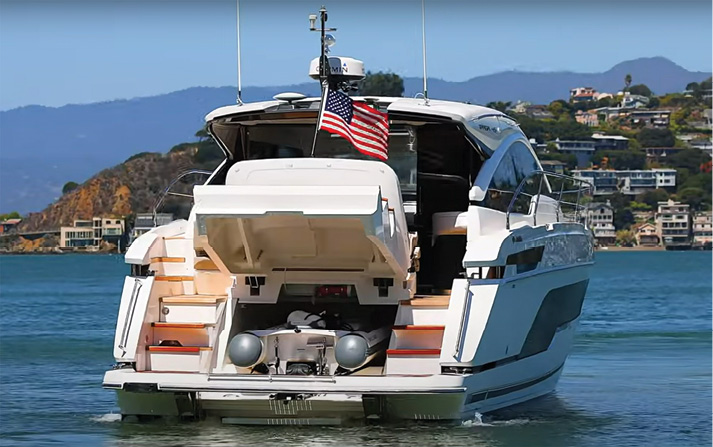
After a thorough walk through with the service manager, this is the first Fairline that I have been aboard. We familiarized ourselves with the boat and quickly started to appreciate the design and attention to detail of this British built top-class luxury motoryacht. I recall thinking that if her performance is as good as her looks, we will get along just fine. Key considerations for our coastal voyage were her lack of a gyro stabilizer and her smallish fuel capacity. These required that we make our voyage plans more carefully around the weather and fuel stops. We discovered the performance was better than expected with good ocean fuel economy and a stable ride. Read on for more.
Day 1 First Leg – Seattle to Grays Harbor
Departing Lake Union and making our way to the Hiram M. Chittenden locks with just 50% fuel and 174 hours on the clocks we plan our first stop in Port Angeles, just 60 miles west, to top up the fuel prior to heading out the Straits of Juan de Fuca. The 30-minute ride down the ship canal provides us a good opportunity to play with the various systems and time to configure the navigation system to my liking while slow cruising at seven knots before getting packed into the locks like sardines in a can. For those of you that have transited the locks, you know how tight it can be, and you cannot be certain of the other boaters’ close quarter maneuvering capabilities. As expected, the Volvo IPS joystick drive system performed well and made easy work of dodging the other guys while they fumbled with lines and forgotten fendering.

The wind and sea forecast looked promising, calling for light westerly winds less than 10 knots all day and a moderate four-foot-long ocean swell. It should be a brisk ride to Port Angeles. As soon as we came around Shilshole Marina and cleared the restricted wake zone we eased the throttles up to 80% load and found ourselves clicking along at 25 knots in quiet comfort. Just 30 minutes later, we shut down the diesel hydronic heating system, opened the retractable sunroof and enjoyed the fresh Puget Sound summer morning air.
After a quick fueling stop in Port Angeles we are off again for the 170-mile run to Grays Harbor. The coastal weather forecast along the Washington Coast from Cape Flattery to Cape Disappointment was ideal and we made the run in our fine British Motoryacht only slowing after we crossed the Grays Harbor bar along the green line and secured her for the night at the Westport Guest Dock.
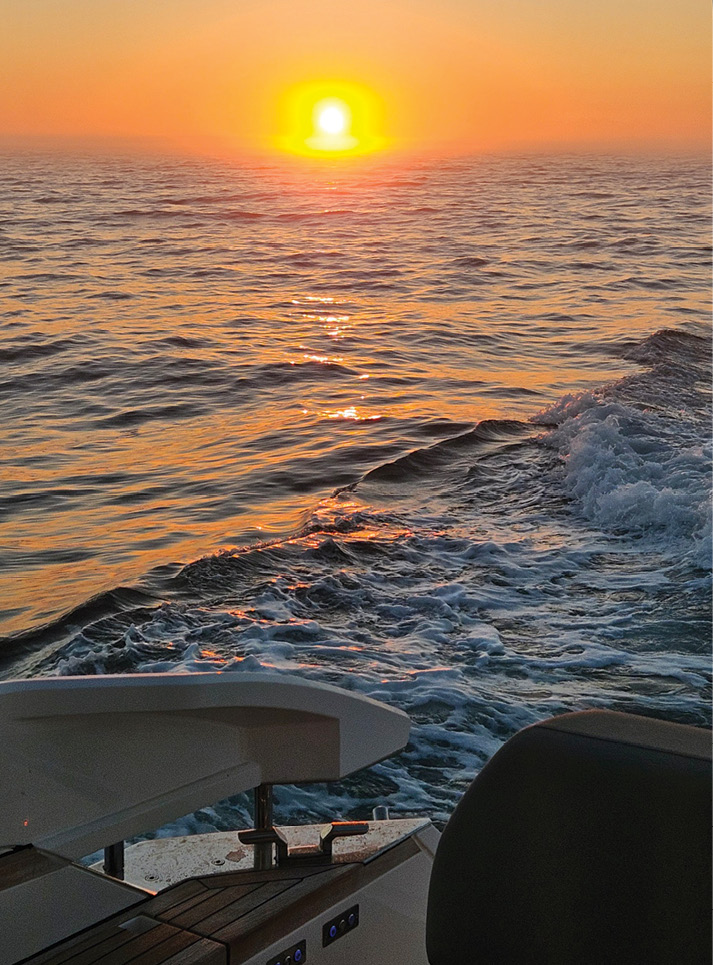
At 80% engine load our Sport Yacht handled the Washington coastal seas with authority, tracking true in the chop with no rattles or shakes when she came off a wave top. After entering Grays Harbor, safely past green number 5 and being comfortable we had plenty of fuel on board to make the fuel dock in the morning. I wanted to get a feel for how well our Targa took the calmer seas in the Grays Harbor anchorage. Easing the throttles to wide open, I waited until we were approaching 30 knots to put the helm hard over. I was pleased to see that our 45 leans comfortably and turns well at speed, doing a complete 360 in about six boat lengths at WOT with minimal slide and an acceptable lean angle. After stopping the boat and then backing down hard into the two-foot wind chop she responded well. From a dead stop pushing the throttles as far forward as she will go, we accelerated well, coming on plane in less than seven seconds and reaching a top SOG of just over 31 knots as indicated on our Garmin navigation system. Fairline states that the 45 GT can make a top speed of 34 knots. In flat water, 10% fuel, and perhaps a little more fiddling with the trim tabs, she probably can. We had two people on board, a 25% fuel load, a 500-pound tender in the garage and full potable water tanks along with wind, tide and a moderate swell. In flat water and a little less load, she will probably get another knot or three.
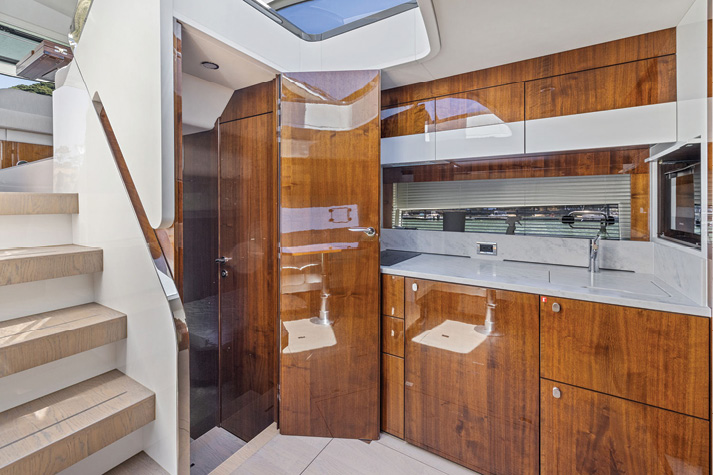
So, enough fun for the day. We had arrived at the Sacramento airport at 0430 and it is now close to 2000, but we have the Targa 220 miles closer to San Francisco and her new home. After a quick dinner ashore, we find time to start exploring the interior and accommodation spaces. Fairline offers a couple of different build options, and I think our tester is the more desirable two-cabin, two-head layout with a walk around queen master aft and the dresser not the settee, a walk around queen VIP forward and a dining table midships opposite the galley instead of the third bunk cabin.
Moving forward it is a mere five steps down the centerline companionway to the accommodation deck where we find a stunning high gloss walnut mezzanine with the longitudinal galley to port and the dining table with comfortable seating for four to starboard.
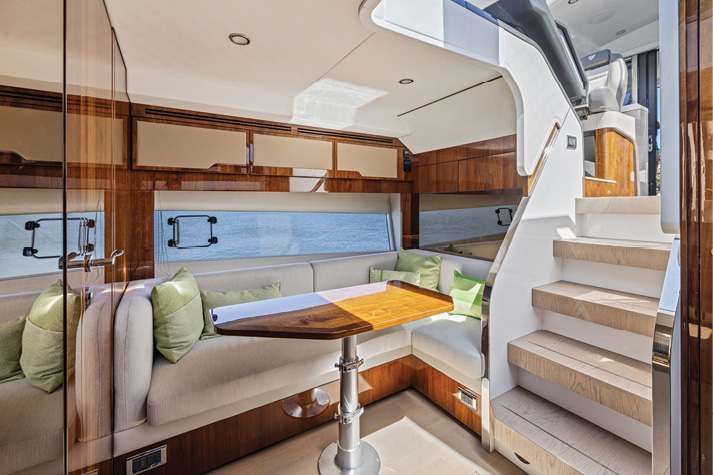
The port side galley includes Corian counters that have a grooved drying area leading to a single basin sink. The cover for the sink reverses to form a cutting surface. Here we find another garage, this time for a convection microwave on the forward bulkhead. At the aft end of the counter is a double burner induction cooktop. All the doors and drawers are soft close. We even find opening port windows on the hull side.
To starboard is the dining area. It features an L-shaped settee wrapping around a high gloss walnut table mounted on a hi-lo pedestal that allows us to convert the area to a bed if needed. In the mezzanine the decking lifts to reveal two very large storage compartments that complement the abundant storage under the dining settee and overhead lockers. The aft overhead locker houses the basic electrical switching for shore power and generator start/stop.

In the mezzanine there are two doors leading forward, one set to port and the other set to starboard with a large frameless floor to ceiling mirror between them. The port side door enters the VIP stateroom where we find the walkaround centerline queen, a hanging locker and storage area on the portside hull and a door to the combination day head and shower to starboard. There are more storage spaces above the hull side windows, and an abundance of storage under the pedestal bed as well as under the countertops. Opening hull windows and an overhead opening hatch bring in the natural light; add all that beautiful walnut and we have a stateroom truly appropriate for your VIP guests.
The starboard door from the mezzanine is access to the forward shared head that is complete with a separate large stall shower, sink, mirrored cabinets and an electric toilet.
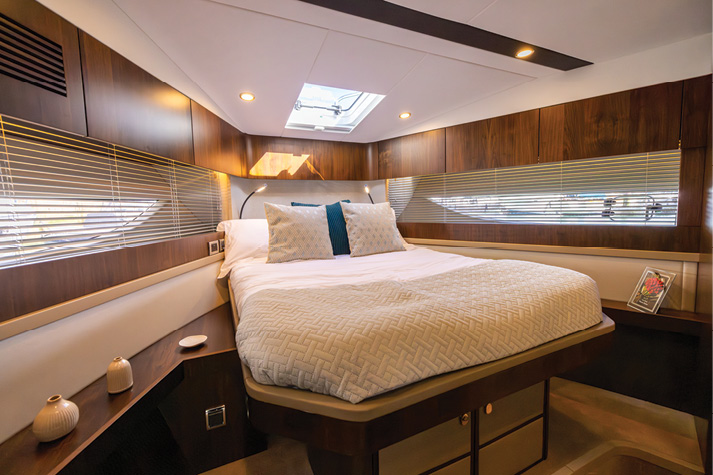
From the mezzanine aft of the galley on the port side we find access to the master stateroom. After passing through the door there is access to the master head to the right and a cabinet to the left that houses the rest of the AC and DC electrical switching. Continue down three steps into the stateroom and we find our yacht has the dresser option which adds six more large storage drawers in addition to the hanging locker to port. Set to starboard is the awarthships queen walkaround berth with additional storage drawers on either side and under the berth. Fairline has designed very large hull side windows on both port and starboard along with opening ports. This is a nice sized stateroom with better than six and half feet of headroom and of course more of that high gloss walnut. The master head has a walk-in shower, storage behind a mirrored door and an electric toilet.
Now really, I am tired and tomorrow will come early as we plan to make another 200+ miles down the coast to southern Oregon.
Day 2 – Grays Harbor to Coos Bay
Fueling in Westport usually starts at 0800, but a call to the fuel dock owner gets us started at 0630. Having taken on 235 gallons of fuel we are back underway and past the Grays Harbor “Alpha” buoy at 0725 and pointed directly for Yaquina Head just 150 miles to the south. As I had run nearly a full tank of red #2 through the engines, I can confirm the engine fuel rate computers are spot on when they indicate at 25 knots we are burning 35 gallons per hour and at WOT our fuel rate is just north of 45 GPH. From the Port Angeles fuel dock to the Westport fuel dock, it is approximately 165 miles which we covered in roughly seven hours and burned 235 gallons of fuel. That works out to nearly 0.7 MPG and a velocity made good of 24 kts. This is respectable fuel economy and just what I would expect from a well-designed 30,000-pound yacht screaming through lumpy seas.
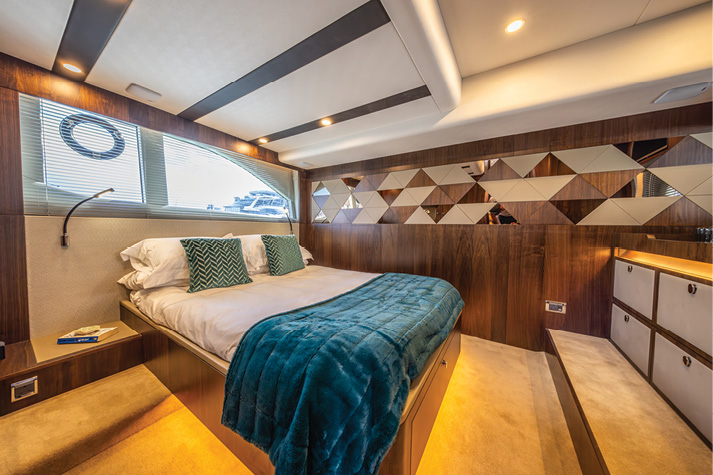
To keep engine hours to a minimum and with favorable wind and sea conditions forecasted for the day, we plan to keep our speed over ground again at 25 knots and make the 240 miles to Charleston Harbor with a fuel stop in South Beach Harbor. It will be another long day, but with behaving seas we will be more than halfway home and still have daylight on departure and arrival.
Crossing the Coos Bay bar and arriving in Charleston Harbor, it was another great day of ocean travel with our speed set to 25 knots, only slowing a little to dodge the occasional isolated thunderstorms between Tillamook and Yaquina Bays. Our fuel stop in South Beach realized the same fuel consumption data we had on day one and the short 70-mile sprint to Coos Bay took only three hours after departing the fuel dock with a full load.
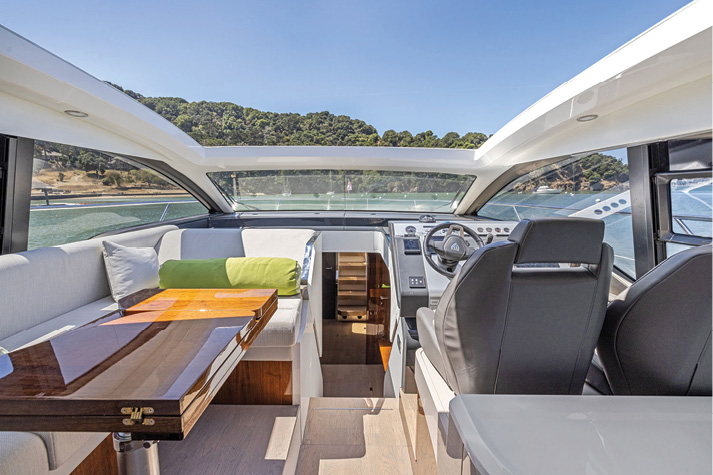
Being Oregon, we find a need to get the hydronic heating system fired up again in order to take the evening chill off. One of the benefits to designing a yacht for the northwest is that having diesel heat of some sort is considered standard equipment.
Day 3 and 4 – Coos Bay to San Francisco
The distance from Charleston Harbor to Humboldt Bay is a short hop of just 150 miles which we expected to make in a long eight hours, fuel dock to fuel dock. There was adverse weather forecast along our intended route around Cape Blanco and Orford Reef in the afternoon which would most likely slow us down. As the distance from the Eureka fuel dock to Bodega Bay is nearly 200 miles and our steed has a range of 190 miles without encroaching on our reserve, there is a need to extend our range. I know of only two ways to extend the range, more fuel or better economy.
Our plan is to top up the fuel in Eureka and then head back out for an overnight run at a fuel conserving 8 knots where we expect double the NMPG of better than 1.5 nautical miles per gallon. Fortunately, the sea condition forecasts along the northern California coast look good for our overnight.
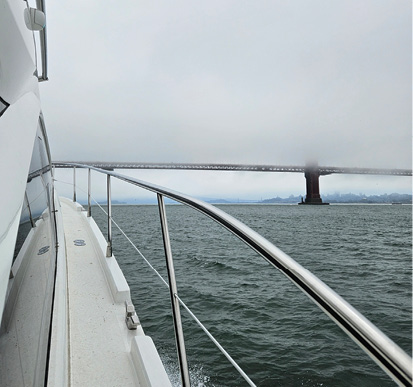
Crossing the Humboldt bar with full fuel and with the afternoon tide at 1730 we can run at as high a speed as the seas allow until nautical twilight and then slow for the 70 miles or so from Noyo River to Point Arena, then power up at first light arriving the Bodega Bay fuel dock after sunrise and position ourselves as the first in line for fueling. As we had a little down time in Eureka after fueling, we utilized the opportunity to poke and prod around the rest of the boat’s interior spaces.
When you enter the vessel, access to the cockpit is via the starboard door and past a sun lounger that extends over the transom and has a reversable backrest, a J-shaped settee and a folding teak table. With the seatback in the aft position there is room for eight around the folding table and with the seatback forward, the sun pad will easily accommodate three. The area is covered with the hard top overhead and the decking is all teak, real teak.

Slide open the glass double door and easily lift the port side flip window with the gas assisted strut and the cockpit and the saloon are now open; let the party begin. On the starboard side of the cockpit there is a small corner-mounted cabinet with a white Corian countertop. Lift the top and we find a sink with an electric grill and plenty of storage along with a trash bin hidden underneath.

In the saloon there is a U-shaped settee to port with an entertainment cabinet to starboard and a high gloss walnut table between. The TV is on a televator lift with storage and an ice maker beneath. The saloon has large hull side windows both port and starboard with opening ports that slide up. The view from any of the seats is unobstructed. Forward of the entertainment center to starboard is the helm station where there are two comfortable and adjustable helm bucket seats with the navigator taking the outside and the skipper the inside. Although this might seem unusual it does put the driver close to the centerline making close quarter maneuvering sightlines better. Since the windscreen is all one piece with no mullions, the operator’s view is unobstructed. For foot comfort there is a fold down pedestal that is just the right height. If more outside visibility is needed, open the sunroof and stand on the pedestal and you have great views for maneuvering.
The ergonomic dash is well laid out with a 12-inch Garmin MFD directly in front of the navigator with a small glove box under and the VHF radio handset on the right. Down the middle of the dash is the Volvo joystick, engine ignitions and the throttle controls. Behind the leather wrapped tilt base wheel on a raised panel is a Volvo seven-inch display and a magnetic compass directly in line with the driver. To the left of the wheel is a Garmin depth display and controls for the wiper/washers. At the top of the dash there is a row of analog gauges for engine RPM and hours, fuel level and engine coolant temperature. Just below is a row of electrical switches for controlling the often-used electrical systems, along with a pair of cup holders.
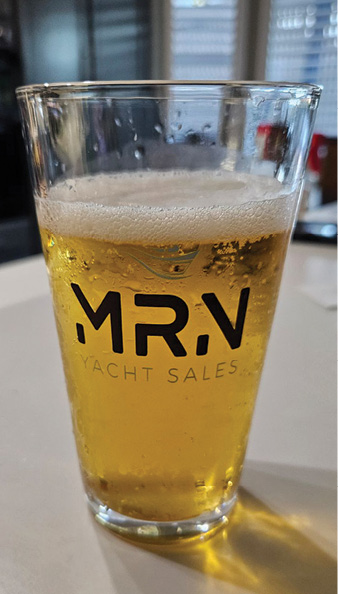
After fueling in Bodega Bay we are back underway in light fog, forcing us to keep our speed down but still intending Clipper Yacht harbor before 1200. Approaching the Golden Gate bridge just a few hours after departure, the fog obscured towers signal we are nearly home.
We spent five days covering 900 plus ocean miles in the Fairline Targa. I was able to get a good sense of her design, build quality and performance. The sporty contemporary style, very European Sport Yacht is definitely a vessel to consider. If you are in the market for a mid-size very upscale yacht, then take a serious look at the Fairline yachts. Examples of high-end touches are everywhere. From the fully gasketed interior doors with magnetic latches that remain recessed until the doors are softly closed, to the beautiful high gloss walnut interior, leather upholstery and impeccable fit and finish, she is definitely in the luxury class.
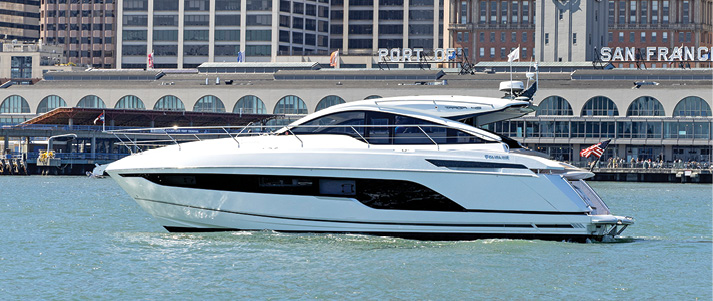
With almost all yacht deliveries, when the boat is secured at her new home we hand the owner a list of needed repairs of items that we have discovered during our time aboard. That list, at times, will have more than 20 items, usually less, sometimes more. This time our list had just a few minor things that could be easily remedied with the proper set of tools. Can I offer suggestions for improvements? Of course, but that is me, and I am never satisfied.
The new owner of our Fairline Targa 45 GT agreed to show her off at the 2nd Annual Sausalito Boat show in October. If you saw her in Sausalito at the boat show then hopefully this boat test will be a review of what you saw. If you did not and you want to arrange your own viewing, then give the local Fairline dealer Rob Newman a call.
MRN Yacht Sales
415-342-2447
rob@mrnyachtsales.com



